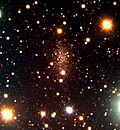Top Qs
Timeline
Chat
Perspective
Pisces Dwarf
From Wikipedia, the free encyclopedia
Remove ads
The Pisces Dwarf, also known as Pisces I,[1] is an irregular dwarf galaxy that is part of the Local Group. The galaxy, taking its name from the constellation Pisces where it appears, is suspected of being a satellite galaxy of the Triangulum Galaxy (M33). It displays a blueshift, as it is approaching the Milky Way at 287 km/s. It may be transition-type galaxy, somewhere between dwarf spheroidal and dwarf irregular. Alternatively, it may be a rare, but statistically acceptable, version of one of the two types.[2]
Remove ads
History
It was discovered by Valentina Karachentseva in 1976.[2][3][4]
Star formation history
Apparently, the star formation rate in the Pisces Dwarf has been declining for the past 10 billion years. Most of the galaxy's stars were formed in its early years, about 8 billion years ago. The study has also shown that there has been no significant star formation for the past 100 million years. Hence, most of the stars that populate this galaxy are old, metal-rich stars aged about 2.5 billion years. However, there are small clusters of young, hot, blue stars on the outer areas of the galaxy.[5]
Remove ads
Gallery
- The Pisces Dwarf in combined UV and visible light
- Hubble image of part of Pisces I
References
External links
Wikiwand - on
Seamless Wikipedia browsing. On steroids.
Remove ads



